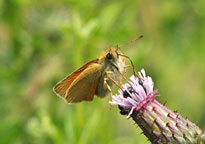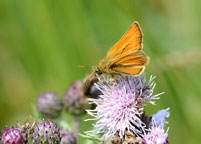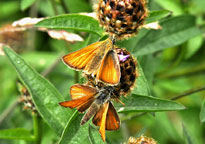Small Skippers are very similar to Essex Skippers. Those with more club-shaped antennae with black tips to the undersides are Essex Skippers, those with
more curved, pointed antennae with orange (or buff to dark brown) patches just below the tips are Small Skippers. These are best looked for with
close-focusing binoculars.
Male Small Skippers also have large orange areas on the lower (ventral)/ inner surfaces of the antennae from just below the tips.
The male wing stripe is broader and more diagonal on the Small Skipper.
The wings generally have narrower black borders with more distinct edges on the upper sides, and the fore-wing undersides have more buff, less
orange-tinted tips.
The adults are on the wing from late June to early August with a peak in July.
The preferred larval food plants are Yorkshire Fog, not uncommon in meadows and wild grassy places.
The Small Skipper over-winters as a larva in small cocoons in grass sheaths on the stems of Yorkshire Fog. If you are lucky enough to have undisturbed grassland with Yorkshire Fog it is important not to cut the long grass where it can be avoided. On my small meadow I control the spread of unwanted tree seedlings and runners and limit the size of the bramble bushes by hand as and when necessary and never cut the grass.







